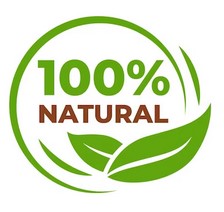Natural on a Food Label: Don’t be Misled
What do you think it means when you see that a food label says that a product is “All Natural” or “100% Natural”?
- Does it mean the product is equivalent to a product labeled USDA Organic?
- That it is lower in calories than a similar product not labeled as natural?
- That it is non-GMO?
- That, if it is an animal product, animals were free-range, not treated with hormones or antibiotics, or that a higher standard for animal welfare was used?
Actually, “All Natural” or “100% Natural” does not mean any of the above.
The U.S. Food and Drug Administration (FDA), which regulates all foods and food ingredients except for meat, poultry, and a few other foods does not have a formal definition for “natural.” The FDA’s policy is that natural means “that nothing artificial or synthetic … has been included in, or has been added to, a food that would not normally be expected to be in that food” (1). The FDA policy does not address the use of pesticides, irradiation, or other food production or processing techniques when a product is labeled “natural.”
USDA regulates meat, poultry, and a few other products and allows those foods to be identified as “natural” if the food supplier does not use artificial ingredients or colors and if minimal processing is done (2). The USDA policy does not address the treatment of the animals or use of hormones or antibiotics.
When consumers see “natural” on a food label, they may choose that product in place of a product labeled “organic” or a product which is produced in a more environmentally friendly way. They may willingly pay more for a product labeled as “natural” (3). As a recent report for USDA’s Economic Research Service (ERS) says, “The economic problem raised by natural labels is that consumers could be paying extra for product attributes they are not receiving while producers of products with those attributes lose sales. As a consequence, any health and environmental stewardship benefits that might have been realized from consumers choosing products that matched their preferences could be lost” (2). Producers have to pay for organic certification; use of “natural” on a label does not require the same sort of fees and documentation.
As of 2018, about 16% of retail food expenditures were for foods labeled “natural” (2). Natural labels were mainly found on processed products. According to the ERS, the dairy food group had the highest frequency of natural claims; grains, vegetables, dried beans, and fruits were much less likely to claim to be “natural” (2). Baby food, vitamins and supplements, chicken and turkey, and cheese were also commonly labeled as “natural” (2).
Don’t be misled, “natural” is a relatively meaningless term on a food label.
References
1. U.S. Food and Drug Administration. Use of the Term Natural on Food Labeling. 2018; https://www.fda.gov/food/food-labeling-nutrition/use-term-natural-food-labeling
2. Kuchler F, Sweitzer M, Chelius C. The Prevalence of the “Natural” Claim on Food Product Packaging. EB-25, USDA, ERS, May, 2023. https://www.ers.usda.gov/webdocs/publications/106479/eb-35.pdf?v=54.2
3. Butler J, Vossler C. What is an unregulated and potentially misleading label worth? The case of natural-labelled groceries. Environ Resour Econ. 2018;70:545-564.

